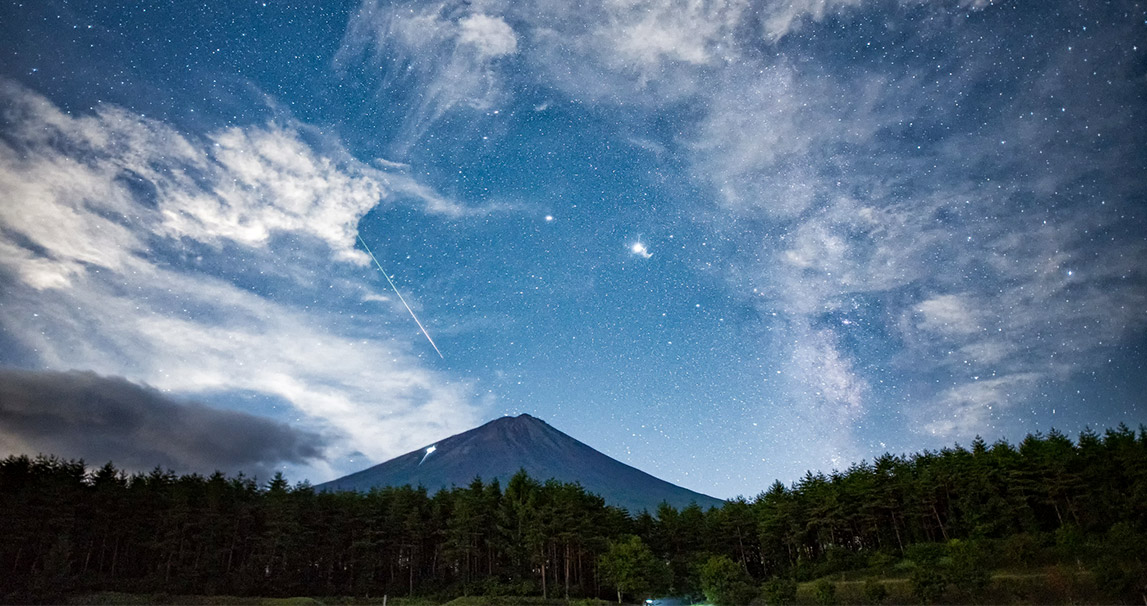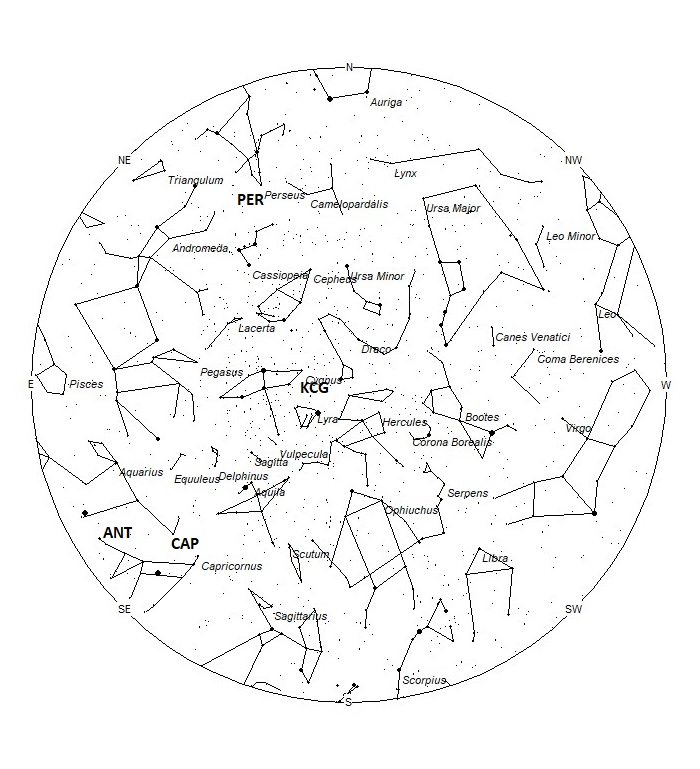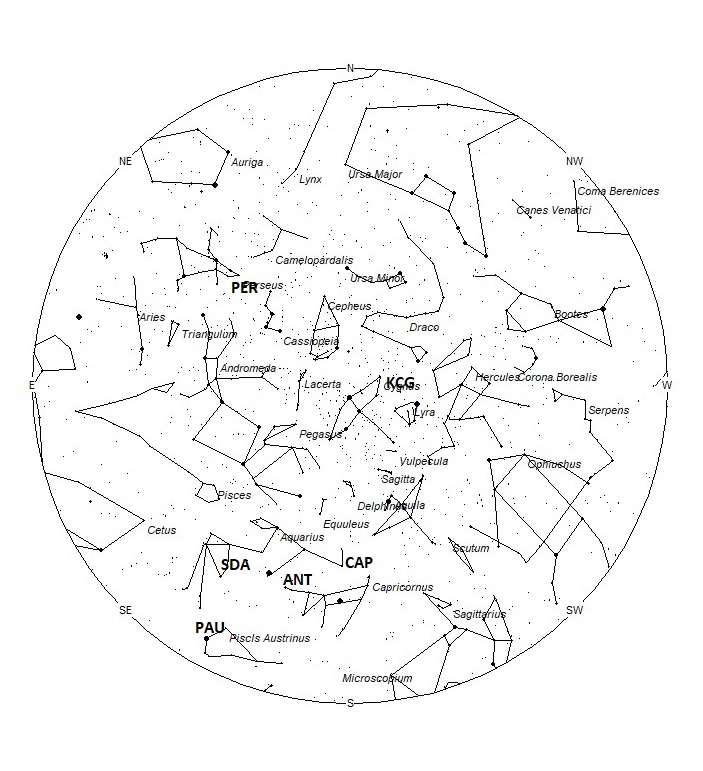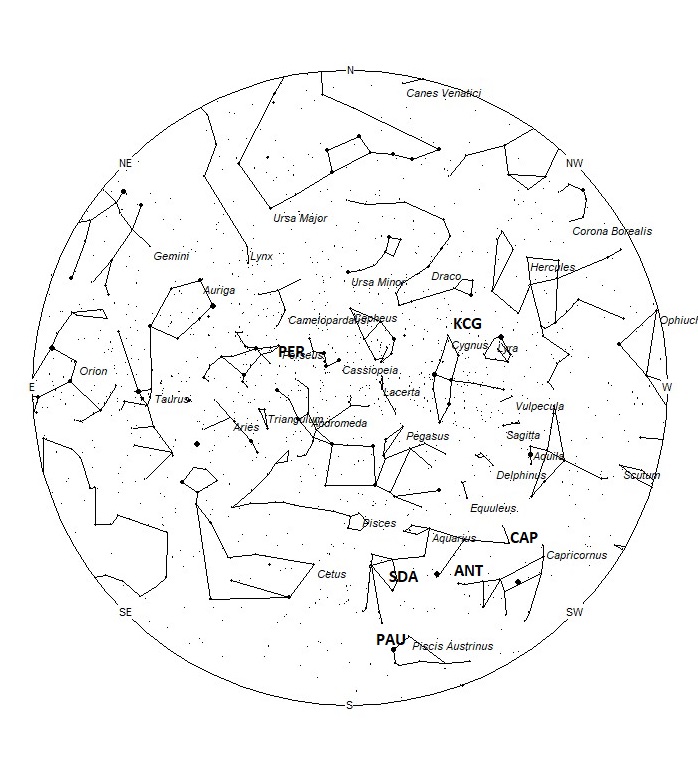
©Takaaki Ito – Nikon D750 20mm F1.8 ISO1600 7sec, Sigma 20mm F1.4 DG HSM
During this period, the moon reaches its last quarter phase on Saturday July 31st. At that time the moon lies 90 degrees west of the sun and rises near midnight local summer time (on August 1st). As the week progresses the waning crescent moon rises later each morning, allowing a better view of the active morning sky as glare from the moon subsides. The estimated total hourly meteor rates for evening observers this week is near 4 as seen from mid-northern latitudes (45N) and 4 as seen from tropical southern locations (25S). For morning observers, the estimated total hourly rates should be near 20 as seen from mid-northern latitudes (45N) and 18 as seen from tropical southern locations (25S). Morning rates are reduced by moonlight during this period. The actual rates will also depend on factors such as personal light and motion perception, local weather conditions, alertness, and experience in watching meteor activity. Note that the hourly rates listed below are estimates as viewed from dark sky sites away from urban light sources. Observers viewing from urban areas will see less activity as only the brighter meteors will be visible from such locations.
The radiant (the area of the sky where meteors appear to shoot from) positions and rates listed below are exact for Saturday night/Sunday morning July 31/August 1. These positions do not change greatly day to day so the listed coordinates may be used during this entire period. Most star atlases (available at science stores and planetariums) will provide maps with grid lines of the celestial coordinates so that you may find out exactly where these positions are located in the sky. A planisphere or computer planetarium program is also useful in showing the sky at any time of night on any date of the year. Activity from each radiant is best seen when it is positioned highest in the sky, either due north or south along the meridian, depending on your latitude. It must be remembered that meteor activity is rarely seen at the radiant position. Rather they shoot outwards from the radiant, so it is best to center your field of view so that the radiant lies at the edge and not the center. Viewing there will allow you to easily trace the path of each meteor back to the radiant (if it is a shower member) or in another direction if it is sporadic. Meteor activity is not seen from radiants that are located far below the horizon. The positions below are listed in a west to east manner in order of right ascension (celestial longitude). The positions listed first are located further west therefore are accessible earlier in the night while those listed further down the list rise later in the night.
These sources of meteoric activity are expected to be active this week.
.
The kappa Cygnids (KCG) are active from August 3-25, with maximum occurring on the 17th. The radiant is currently located at 18:48 (282) +57. This position lies in northern Lyra, 9 degrees northeast of the zero magnitude star known as Vega (alpha Lyrae). This radiant is best placed near 2300 local summer time (LST) when it lies on the meridian and is located highest in the sky. With a high northern declination, these meteors are difficult to view from the southern hemisphere. Expected hourly rates this week are less than 1 no matter your location. With an entry velocity of 25 km/sec., the average meteor from this source would be of slow velocity.
The alpha Capricornids (CAP) are active from July 3 through August 15, peaking on July 30th. The radiant is currently located at 20:36 (309) -09. This position lies in northwestern Capricornus, 4 degrees northeast of the naked eye double star known as (alpha Capricornii). Current rates are expected to be near 2 per hour as seen from the Northern Hemisphere and 3 per hour as seen from south of the equator. These meteors are best seen near 01:00 LST, when the radiant lies highest in the sky. With an entry velocity of 23 km/sec., the average meteor from this source would be of slow velocity.
The center of the large Anthelion (ANT) radiant is currently located at 21:24 (321) -13. This position lies in northeastern Capricornus, 3 degrees northwest of the 3rd magnitude star known as Deneb Algedi (delta Capricornii Aa). Due to the large size of this radiant, Anthelion activity may also appear from northwestern Aquarius as well as Capricornus. This radiant is best placed near 2100 LST, when it lies on the meridian and is located highest in the sky. Rates at this time should be near 2 per hour as seen from the Northern Hemisphere and 3 per hour as seen from south of the equator. With an entry velocity of 30 km/sec., the average Anthelion meteor would be of slow velocity.
The Southern delta Aquariids (SDA) are active from a radiant located at 22:48 (342) -15. This area of the sky is located in southwestern Aquarius, 2 degrees northwest of the 3rd magnitude star known as Skat (delta Aquarii). This radiant is best placed near 0300 LST, when it lies on the meridian and is located highest in the sky. Hourly rates at this time should be near 3 as seen from the Northern Hemisphere and near 5 as seen from south of the equator, where the radiant lies higher in the sky. With an entry velocity of 41 km/sec., the average meteor from this source would be of medium velocity.
The Piscids Austrinids (PAU) are an obscure shower, not well seen from the northern hemisphere. IMO visual studies show it to be active from July 15 to August 10, peaking on July 29th. The current position of the radiant is 23:00 (345) -28. This area of the sky is located in eastern Piscis Austrinus, 2 degrees north of the bright star known as Fomalhaut (alpha Piscis Austrini). The radiant is best placed near 03:00 LST, when it lies highest in the sky. Current hourly rates should be less than 1 no matter your location. With an entry velocity of 35km/sec., most activity from this radiant would be of medium velocities.
The Perseids (PER) are active from a radiant located at 02:08 (032) +55. This position lies in northwestern Perseus, just 2 degrees southwest of the Double Cluster in Perseus. This area of the sky is best placed for viewing during the last dark hour before dawn when it lies highest in the sky. Maximum is not until August 12th so current rates are expected to be near 3 as seen from the Northern Hemisphere and less than 1 as seen from south of the equator. With an entry velocity of 59 km/sec., the average meteor from this source would be of swift velocity.
As seen from the mid-northern hemisphere (45N) one would expect to see approximately 10 sporadic meteors per hour during the last hour before dawn as seen from rural observing sites. Evening rates would be near 3 per hour. As seen from the tropical southern latitudes (25S), morning rates would be near 8 per hour as seen from rural observing sites and 3 per hour during the evening hours. Locations between these two extremes would see activity between the listed figures. Morning rates are reduced due to moonlight.
| SHOWER | DATE OF MAXIMUM ACTIVITY | CELESTIAL POSITION | ENTRY VELOCITY | CULMINATION | HOURLY RATE | CLASS |
| RA (RA in Deg.) DEC | Km/Sec | Local Summer Time | North-South | |||
| kappa Cygnids (KCG) | Aug 13 | 18:48 (282) +57 | 25 | 23:00 | <1 – <1 | II |
| alpha Capricornids (CAP) | Jul 31 | 20:36 (309) -09 | 23 | 01:00 | 2 – 3 | II |
| Anthelion (ANT) | – | 21:24 (321) -13 | 30 | 02:00 | 1 – 2 | II |
| Southern delta Aquariids (SDA) | Jul 30 | 22:48 (342) -15 | 41 | 03:00 | 3 – 5 | I |
| Piscids Austrinids (PAU) | Aug 07 | 23:00 (345) -28 | 35 | 03:00 | <1 – <1 | IV |
| Perseids (PER) | Aug 12 | 02:08 (032) +55 | 59 | 07:00 | 3 – <1 | I |







 You saw something bright and fast? Like a huge shooting star? Report it: it may be a fireball.
You saw something bright and fast? Like a huge shooting star? Report it: it may be a fireball.  You counted meteors last night? Share your results with us!
You counted meteors last night? Share your results with us!  You took a photo of a meteor or fireball? You have a screenshot of your cam? Share it with us!
You took a photo of a meteor or fireball? You have a screenshot of your cam? Share it with us!  You caught a meteor or fireball on video? Share your video with us!
You caught a meteor or fireball on video? Share your video with us!